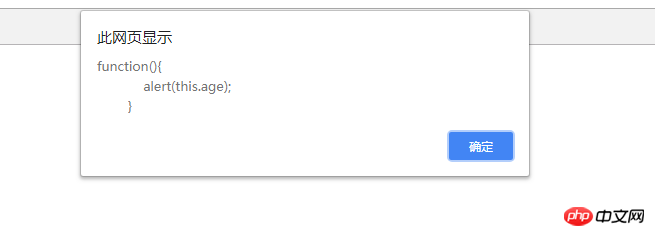JS 的物件導向中繼承的那些小事(實例)
- 青灯夜游原創
- 2018-09-15 16:17:081170瀏覽
本章跟大家介紹JS 的物件導向中繼承的那些小事(實例),讓大家了解js中的繼承特點是什麼?物件導向中繼承的一些小知識。有一定的參考價值,有需要的朋友可以參考一下,希望對你有幫助。
JS中繼承的特點:
#1、子類別繼承父類別;
2、子類別可以用父類別的方法和屬性
3、子類別的改變可以不影響父類別
下面用一個例子來說明JS 的繼承
這段程式碼創建了一個父類以及它的原型,同時也創建了一個子類,並繼承了父類的私有屬性
<script>
//这是父类
function Father(name,age,marry){
this.name=name;
this.age=age;
this.marry=marry;
}
//父类的原型
Father.prototype.showName=function(){
alert(this.name);
}
//子类
function Son(name,age,marry,weight){
Father.call(this,name,age,marry);
this.weight=weight;
}
</script>當子類Son想繼承父類的原型時,我的做法一開始是這麼做的
<script>
//这是父类
function Father(name,age,marry){
this.name=name;
this.age=age;
this.marry=marry;
}
//父类的原型
Father.prototype.showName=function(){
alert(this.name);
}
//子类
function Son(name,age,marry,weight){
Father.call(this,name,age,marry);
this.weight=weight;
}
//错误的做法
Son.prototype=Father.prototype;
Son.prototype.showAge=function(){
alert(this.age);
}
var father=new Father('王大锤',30,true);
alert(father.showAge);
</script>
運行的結果可以發現,子類別原型的改變影響了父類別的原型,而父類別的原型中本來是沒有showAge方法的,這就違背了前面繼承的第三個特點了。
分析原因:上面程式碼的第20行 Son.prototype=Father.prototype;這裡的'=' 兩邊都是對象,那麼它代表的意思就是引用,如果是引用的話,左邊的對象改變,肯定會影響了右邊的對象。所以才出現了子類別原型的改變影響了父類別的原型。
解決方法
方法一:核心思路,前面的問題不是說'=' 是引用的關係才導致問題的嘛,那這裡就保證'= ' 永遠是賦值的關係,而不是引用。這裡就定義一個 Clone() 方法,將父類別物件拷貝給子類別。
Clone() 方法裡用到遞歸的原因是,在拷貝的過程中物件中可能嵌套物件。
<script>
//这是父类
function Father(name,age,marry){
this.name=name;
this.age=age;
this.marry=marry;
}
//父类的原型
Father.prototype.showName=function(){
alert(this.name);
}
//子类
function Son(name,age,marry,weight){
Father.call(this,name,age,marry);
this.weight=weight;
}
Son.prototype=new Clone(Father.prototype);
Son.prototype.showAge=function(){
alert(this.age);
}
var father=new Father('王大锤',30,true);
alert(father.showAge);
//通过克隆对象:核心思路是保证 '=' 是赋值的关系,而不是引用,也就是保证 '=' 的右边不是对象
function Clone(obj){
for(var i=0;i<obj.length;i++){
if(typeof(obj[key]=='object')){
this.key=new Clone(obj[key]);
}else{
this.key=obj[key];
}
}
}
</script>
方法二:程式碼很簡單,但是很難想到,沒有第一個方法那麼好理解。核心思想:物件自身屬性的改變,不會影響其建構函數的屬性的改變。
<script>
//这是父类
function Father(name,age,marry){
this.name=name;
this.age=age;
this.marry=marry;
}
//父类的原型
Father.prototype.showName=function(){
alert(this.name);
}
//子类
function Son(name,age,marry,weight){
Father.call(this,name,age,marry);
this.weight=weight;
}
function fn(){}
fn.prototype=Father.prototype;
Son.prototype=new fn();
Son.prototype.showAge=function(){
alert(this.age);
}
var father=new Father('王大锤',30,true);
alert(father.showAge);
//通过克隆对象:核心思路是保证 '=' 是赋值的关系,而不是引用,也就是保证 '=' 的右边不是对象
// Son.prototype=new Clone(Father.prototype);
// function Clone(obj){
// for(var i=0;i<obj.length;i++){
// if(typeof(obj[key]=='object')){
// this.key=new Clone(obj[key]);
// }else{
// this.key=obj[key];
// }
// }
// }
</script>
以上是JS 的物件導向中繼承的那些小事(實例)的詳細內容。更多資訊請關注PHP中文網其他相關文章!
陳述:
本文內容由網友自願投稿,版權歸原作者所有。本站不承擔相應的法律責任。如發現涉嫌抄襲或侵權的內容,請聯絡admin@php.cn

